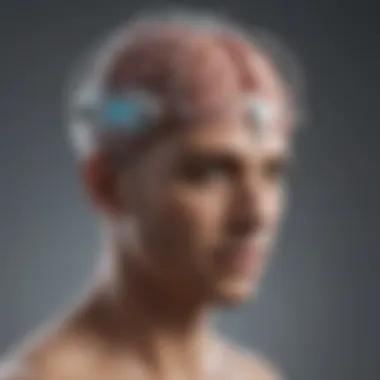Deep Brain Stimulation at Emory: Advances and Implications


Intro
Deep Brain Stimulation (DBS) represents a significant shift in the treatment of various neurological disorders. It involves the implantation of electrodes within specific regions of the brain to modulate neuronal activity. Emory University has positioned itself at the forefront of DBS research, exploring the potential of this technology and its implications for patient care. This article will delve into the advancements made in DBS at Emory, covering its applications, mechanisms, ethical considerations, and future directions in research.
DBS therapy has proven to be influential for conditions like Parkinson's disease, essential tremor, and dystonia. With continued studies emerging from Emory, it becomes essential to assess how these advancements contribute to the wider medical community.
Understanding the impact of these findings can provide essential insights for students, researchers, educators, and professionals engaged in neuroscience and medical practices.
Preamble to Deep Brain Stimulation
Deep brain stimulation (DBS) represents a significant advancement in the treatment of various neurological disorders. As a procedure, it aims to modulate abnormal neuronal activity through the delivery of electrical impulses. This introduction sets the foundation for understanding how DBS operates, its historical significance, and the role of Emory University in this transformative field.
Definition and Mechanisms
DBS involves placing electrodes in specific areas of the brain. These electrodes are connected to a pulse generator, typically implanted under the skin in the chest. The device sends targeted electrical signals to the brain, helping to restore normal function and alleviate symptoms.
The specific mechanisms by which DBS exerts its effects are complex. It is known to influence neuronal circuitry and alter the release of neurotransmitters, promoting a more balanced state in the brain. This technology has been particularly beneficial for conditions such as Parkinson's disease and essential tremor.
Historical Background
The root of DBS can be traced back to the late 20th century. Early experiments with electrical stimulation of the brain were rudimentary, primarily focusing on understanding the electrical properties of neuronal cells. The formal application of DBS began in the 1980s, following foundational research by medical scientists such as Alim-Louis Benabid.
As technology progressed, so did the understanding of patient care and device optimization. Today, numerous clinical trials further support the capabilities and potential of DBS, validating its impact on quality of life for patients. As such, the evolution of deep brain stimulation is marked by both scientific innovation and a commitment to enhancing patient outcomes.
Emory University’s Role in DBS Research
Emory University stands as a pivotal institution in the realm of deep brain stimulation (DBS) research. Its significance is underscored by a blend of academic rigor, clinical expertise, and an unwavering commitment to advancing neurological treatments. This section delves into the institutional framework that supports DBS initiatives and highlights the key research activities that position Emory at the forefront of this evolving field.
Institutional Overview
Emory University is recognized for its comprehensive approach to healthcare and medical research. The institution houses a robust network of facilities, including the Emory University Hospital, which is renowned for its specialized departments. One key element is the Emory Brain Health Center, where multidisciplinary teams focus on neurology, neurosurgery, and psychiatric disorders. This environment fosters collaboration among neuroscientists, clinicians, and engineers, enabling cutting-edge research to flourish.
Moreover, Emory’s dedicated research institutes, such as the Yerkes National Primate Research Center, offer unique opportunities for preclinical studies essential for DBS advancements. The combination of clinical and research capabilities creates a solid platform that enhances understanding of brain functions and the effects of stimulation.
Key Research Initiatives
At Emory, several premier research initiatives are advancing DBS applications. One notable effort is the exploration of tailored stimulation protocols aimed at optimizing patient outcomes. These protocols are designed to adjust stimulation parameters to individual patients’ needs, addressing specific symptoms effectively.
Additionally, researchers are investigating the neurological impact of DBS on conditions beyond movement disorders. Studies are underway that evaluate its effects on psychiatric conditions, such as depression and obsessive-compulsive disorder. By broadening the scope of DBS, Emory aims to offer innovative treatments for patients who do not respond well to traditional therapies.
Collaboration also features prominently in Emory’s initiatives, exemplified by partnerships with industry leaders in neurotechnology. This collaboration facilitates the development of next-generation DBS devices, incorporating advancements in AI and machine learning to enhance precision in therapy.
"Emory’s comprehensive framework for DBS research embodies the spirit of innovation essential for the future of neuromodulation therapies."
Through these key research initiatives, Emory University continues to lead the way in resolving complex questions around DBS. Their efforts not only contribute to the academic field but ultimately enhance clinical practices, offering hope for many patients suffering from debilitating neurologic disorders.
This section illustrates Emory University's critical contribution to the landscape of deep brain stimulation research. By understanding the institutional context and key initiatives, readers can appreciate the ongoing evolution and implications of DBS as a transformative therapeutic avenue.
Clinical Applications of DBS
Deep Brain Stimulation (DBS) is becoming a pivotal intervention for various neurological and psychiatric disorders. At Emory University, research underscores its potential to significantly enhance patient quality of life. Understanding DBS's clinical applications is essential because it reveals how this technology can alleviate symptoms when conventional treatments fail. The effective deployment of DBS can transform treatment landscapes for conditions like Parkinson’s disease, essential tremor, and obsessive-compulsive disorder.
Parkinson’s Disease
Parkinson's disease is a progressive neurological disorder marked by tremors, rigidity, and bradykinesia. Traditionally managed with medications like levodopa, some patients experience diminishing returns as the disease advances. DBS serves as a remarkable alternative, particularly for those who no longer achieve adequate relief from medications. By stimulating specific brain regions, DBS can reduce tremors and improve motor function, allowing many patients to regain a semblance of normalcy in daily activities.
The procedure involves implanting electrodes in targeted areas of the brain, such as the subthalamic nucleus. These electrodes send electrical impulses that modulate abnormal brain activity. A tailored stimulation program is critical, as each patient's response can vary significantly. Thus, the careful selection and adjustment of stimulation parameters by trained medical professionals are vital for maximizing benefits and minimizing side effects.


Essential Tremor
Essential tremor, distinct from Parkinson's, primarily affects voluntary movements, leading to uncontrollable shaking, especially in the hands. Although treatments include medications like propranolol or primidone, many patients find these insufficient. DBS becomes an advantageous solution, offering substantial symptom relief when other methods are ineffective.
As with Parkinson’s, DBS is focused on altering neuronal circuits associated with tremor generation. The targeted regions typically include the ventral intermediate nucleus of the thalamus. Patients often report immediate improvements in tremor control after DBS initiation, making it a desirable option for those suffering from severe tremor-related disability.
Obsessive-Compulsive Disorder
Obsessive-compulsive disorder (OCD) poses unique challenges, often requiring a multifaceted treatment approach that includes therapy and medications. However, some patients remain resistant to these standard treatments. In such cases, DBS has emerged as a promising experimental option. Research at Emory and other institutions demonstrates that stimulating specific areas of the brain, such as the anterior cingulate cortex or orbitofrontal cortex, can lead to significant reductions in obsessive thoughts and compulsive behaviors.
The use of DBS for OCD, although still in the exploratory stage, shows a promising track record for select patients. As we continue to learn more about the neural underpinnings of OCD, further refinements in patient selection and stimulation protocols may enhance the effectiveness of this intervention. The ongoing research in this area signifies a shift toward personalized medicine, where treatment is tailored to the unique neurobiology of each patient.
"DBS is not merely an alternative but represents a broader era of therapeutic approaches, especially for chronic conditions that have resisted conventional treatments."
Technological Innovations in DBS
Technological innovations in deep brain stimulation (DBS) play a vital role in advancing healthcare treatments for neurological disorders. At Emory University, research is focusing on how these technologies improve patient outcomes and enhance the overall efficacy of DBS systems. Various technological advancements lead to significant improvements in device design and functionality, making it essential to understand their implications in clinical and research settings.
New devices and techniques are now aimed at optimizing stimulation to reduce side effects, enhance response precision and increase adaptability of therapy to individual patient needs. The need for constant innovation is clear, with many patients benefitting from refined systems that incorporate the latest findings in neuroscience.
Advancements in Device Design
In recent years, there have been remarkable advancements in the design of DBS devices. These technological improvements include better electrode configurations, programming software, and more responsive control systems. For example, the introduction of directional leads allows for more targeted stimulation of specific brain regions, reducing the chance of unintended side effects.
The durability and longevity of DBS systems are also under continuous enhancement. Modern devices often feature rechargeable batteries, decreasing the need for surgical interventions. This can significantly improve the quality of life for patients by minimizing disruption and maintaining effective treatment over extended periods. Technical improvements involve a boad cut down of the initial surgical risk associated with device implantations, allowing for a greater patient population to consider this treatment option.
Additionally, ongoing research on biocompatibility is crucial. Ensuring that materials used in devices do not induce adverse tissue reactions can lead to safer implants and better long-term outcomes for patients.
Miniaturization and Portability
The trend towards miniaturization and portability in DBS technology also holds immense significance. Smaller devices are easier to implant, cause less trauma during surgery, and enhance the comfort of the patient. Such improvements in size and portability allow for a more seamless integration of DBS technology into a patient's daily life.
Miniaturized systems often incorporate wireless technologies that facilitate adjustments by healthcare professionals without the need for physical access to the device. This can create quicker, more dynamic treatment adjustments and enhance a physician’s ability to monitor a patient’s response remotely.
"The shift towards smaller, more portable devices could redefine the landscape of neuromodulation therapy and improve patient satisfaction dramatically."
In summary, the technological innovations in DBS at Emory exemplify the ongoing commitment to improving patient care. Advancements in device design and miniaturization strategies can enhance safety profiles, patient experience, and treatment outcomes. These innovations are instrumental in addressing the unique challenges faced by individuals with neurological disorders, paving the way for more personalized and effective therapies.
The Mechanism of Action
Understanding the mechanism of action behind deep brain stimulation (DBS) is crucial for comprehending its effectiveness in treating various neurological disorders. This section delves into the specific neuronal circuitry involved in DBS as well as the effects of this stimulation on neurotransmitters. These insights not only heighten the awareness of how DBS works but also facilitate ongoing advancements in this field.
Neuronal Circuitry Involved
The neuronal circuitry involved in DBS consists of several key brain regions. The primary targets for stimulation include areas such as the subthalamic nucleus, globus pallidus, and thalamus. These regions play significant roles in motor control and emotional regulation, making them essential in addressing conditions like Parkinson's disease and essential tremor.
Activation of specific neural pathways can lead to modulation of abnormal firing rates, which are often a hallmark of neurological disorders. For example, in Parkinson's disease, there's an imbalance in the basal ganglia circuit. Through precise stimulation, DBS can restore a more balanced neural activity.
"The targeted approach of DBS allows clinical practitioners to fine-tune treatment for specific symptoms, enhancing patient outcomes."
This aspect of neuronal circuitry is fundamental because it permits DBS to be tailored for individual needs. Clinicians at Emory University continually seek to optimize stimulation parameters for better patient outcomes. This ongoing research adds depth to the understanding of how stimulation alters neuronal networks effectively.
Effects on Neurotransmitters
DBS has profound effects on neurotransmission, most notably through the release and uptake of certain neurotransmitters. Key neurotransmitters affected include dopamine, glutamate, and gamma-aminobutyric acid (GABA). Dopaminergic neurons are most often impacted, especially in diseases like Parkinson's where dopamine deficiency contributes to motor symptoms.
Research indicates that DBS enhances dopaminergic signaling through its action on the basal ganglia circuitry. This may alleviate some motor symptoms and improve overall quality of life for patients.


In addition to dopamine, the modulation of glutamate and GABA can lead to changes in excitatory and inhibitory signaling within the brain. Specifically, DBS appears to increase GABAergic inhibition and alter glutamatergic transmission, which may further contribute to symptomatic relief in affected individuals.
Continued investigation into these neurotransmitter dynamics is critical for the development of more effective DBS protocols, particularly as research shifts towards personalized brain stimulation approaches.
By understanding the interplay between neuronal circuitry and neurotransmitter effects, researchers can enhance therapeutic outcomes and refine DBS as a viable treatment option for a wider array of neurological conditions.
Patient Selection Criteria
The process of selecting appropriate patients for deep brain stimulation (DBS) is a critical aspect of the overall treatment strategy. This selection process is not merely a formality but an intricate evaluation that determines the likelihood of therapeutic success. Patient selection criteria must be meticulously outlined based on a combination of clinical, psychological, and social considerations. When a patient is identified as a potential candidate, a well-defined framework has to be followed to ensure optimal outcomes and mitigate risks.
Clinical Evaluation Process
The clinical evaluation process encompasses a detailed review of the patient's medical history, current health status, and the specific neurological condition being treated. Physicians at Emory University adopt a multi-disciplinary approach, involving neurologists, neurosurgeons, and other healthcare professionals. This team conducts comprehensive assessments, including:
- Neurological examinations: These tests assess the severity of symptoms related to conditions like Parkinson's disease or essential tremor, allowing for an understanding of how DBS might alleviate these symptoms.
- Imaging studies: Techniques such as MRI or CT scans provide important information about brain structure and any anatomical changes that may affect DBS intervention.
- Response to medications: Evaluating how the patient responds to existing pharmacological treatments helps in determining the potential effectiveness of DBS.
Careful documentation during this clinical evaluation is essential. This record not only influences immediate treatment decisions but also facilitates future research initiatives and patient follow-ups.
Psychiatric Assessments
In addition to clinical evaluations, psychiatric assessments are fundamental in the patient selection process for DBS. This aspect is essential, as neurological conditions often co-exist with psychological disorders. At Emory, a thorough psychiatric evaluation helps in identifying any underlying mental health issues that could complicate the treatment trajectory.
The assessments generally include:
- Psychological screening tests: These tests can identify depression, anxiety, or other mental health issues that might influence treatment outcomes.
- Risk evaluation: Understanding a patient's risk for adverse events, including the emotional response to surgery, is crucial.
- Informed consent discussions: Patients must be able to comprehend the benefits and risks of DBS and have the capacity to give informed consent for the procedure.
In summary, clear and comprehensive patient selection criteria form the backbone of successful DBS interventions. The clinical evaluation and psychiatric assessments help identify candidates who are most likely to benefit from DBS while also preparing them for the complexities of the treatment process.
Ethical Considerations in DBS
The application of Deep Brain Stimulation (DBS) at Emory University raises significant ethical questions that are crucial for effective clinical practice. As with many advanced medical interventions, the implications of DBS extend beyond its technical aspects. Ethics ensure that both patients and providers engage in responsible behavior throughout the treatment process. Addressing these considerations is vital as DBS technologies evolve.
One critical area is informed consent. Patients undergoing DBS must fully understand the nature of the procedure, including its potential risks and benefits. It is not simply enough to secure agreement; the consent process requires comprehensive education for patients. Many might not fully grasp the operational mechanisms of DBS or the long-term commitments associated with it. Ensuring that patients can make informed decisions is a fundamental ethical obligation.
Informed consent is a multi-faceted process. There should be clarity around:
- The goals of the DBS procedure.
- Possible side effects and outcomes.
- The duration of stimulation and required follow-up.
- Alternatives to DBS, if available.
Medical professionals are responsible for facilitating this dialogue, ensuring that patients are not pressured into decisions nor left in a state of uncertainty.
Informed Consent
Informed consent encompasses more than just signing a form. It is a dialogue between patient and clinician. Clinicians should ensure that patients comprehensively understand both the potential benefits and drawbacks of DBS treatments. The nuances involved include discussing realistic expectations, timelines for improvement, and any complications linked to the surgery.
Moreover, alterations in a patient's identity or personality, which can result from deep brain stimulation, may introduce complex scenarios when explaining outcomes. This necessitates ongoing conversations even after the consent is granted. A responsible approach should involve continuously updating the patient as new information emerges about the technique or their specific condition.
Potential for Misuse of Technology
The potential misuse of DBS technology is another significant ethical concern. As the capabilities of DBS expand, so does the risk of its application for non-therapeutic purposes. There is a troubling potential for DBS to be utilized in ways that could alter behavior or enhance cognitive functions beyond therapeutic needs.
This raises many societal questions:
- What boundaries should exist regarding the enhancement of cognitive function or mood?
- Is it ethical to use DBS for purposes other than treating neurological disorders?
- Who determines acceptable uses of technology?
These uncertainties highlight the need for regulatory frameworks governing DBS applications. Proper guidelines are essential to prevent deviations from ethical standards. As DBS becomes more prominent in mental health and neurological treatment, it is critical to remain vigilant against its misuse.


"Advances in technology always necessitate a corresponding evolution in ethical considerations."
Challenges in DBS Therapy
Deep Brain Stimulation (DBS) has witnessed substantial advancements in technology and application. However, the journey toward effective and safe DBS therapy is not without its challenges. Addressing these challenges is crucial not only for patients but also for the broader medical community involved in neurological care. This section focuses on two key aspects of the challenges associated with DBS: post-surgical complications and long-term efficacy, both of which highlight significant elements of importance.
Post-Surgical Complications
Post-surgical complications are a notable concern following DBS procedures. Although the overall success rates for DBS are encouraging, specific risks remain present. Surgical errors and complications such as infection or hemorrhage can occur, which may impact the responsiveness to therapy and the patient's overall experience.
Some common post-surgical complications include:
- Infection: This can occur at incision sites or deeper within the body, necessitating monitoring and sometimes additional treatments.
- Hemorrhage: Uncontrolled bleeding in the brain or surrounding areas can lead to complications that may require intervention.
- Hardware issues: Problems with the implanted device or leads can arise, necessitating surgical revision.
- Adjustments to settings: Since optimal stimulation parameters vary among patients, finding the right settings can take time, leading to temporary ineffectiveness.
Each complication has implications for the timeline of recovery and for the ultimate effectiveness of DBS. Careful selection of candidates for surgery and detailed preoperative planning can minimize some of these risk factors.
Long-term Efficacy
Long-term efficacy of DBS is another critical area of focus. While many patients experience significant improvement in symptoms, the durability of these benefits over time remains uncertain. Factors influencing long-term outcomes may include the following:
- Parcels of brain targeted: The specific areas of stimulation can yield varied results based on individual pathology.
- Neuroadaptive changes: Over time, the brain may potentially adapt to stimulation, which may necessitate adjustments in settings or even device replacement.
- Patient-related variables: Individual differences in physiology and disease progression can significantly affect outcomes.
Meta-analyses and longitudinal studies are essential to understanding these variations in efficacy. The ongoing collection of data will enable researchers to develop strategies for mitigating losses in stimulation effectiveness over time.
"Identifying and addressing challenges in DBS therapy are essential in improving patient outcomes and understanding the long-term implications of the technology."
Future Directions in DBS Research
As deep brain stimulation (DBS) continues to evolve, its future research directions are crucial for enhancing therapeutic outcomes and broadening applications. Understanding these prospective pathways allows researchers and practitioners to anticipate improvements in treatment efficacy and patient care. The ongoing exploration also addresses essential technical and ethical considerations that arise as the technology becomes more sophisticated.
Integration with Diagnostic Technologies
The integration of diagnostic technologies into DBS presents a unique opportunity to refine treatment protocols. By combining imaging techniques such as functional MRI or PET scans with real-time monitoring data, clinicians can gather invaluable insights into patient neurological functions. This multidimensional approach can enhance the precision of stimulation parameters, leading to improved outcomes.
Furthermore, integrating wearable tech can facilitate continuous data collection, allowing for adjustments based on real-time patient responses. This proactive model not only informs clinical decisions but also empowers patients by offering more personalized care. As the field advances, ensuring effective communication between diagnostic and therapeutic devices will be vital for the safety and effectiveness of DBS.
Personalized Brain Stimulation Approaches
Personalization in DBS therapy is a promising front in the field. Each patient's brain anatomy and neurophysiology are unique, thus responding differently to stimulation. Future research aims for precision medicine tailored to individual characteristics. Innovations may include mapping the specific neural circuits involved in a patient's symptoms and adapting stimulation parameters accordingly.
The use of machine learning algorithms can enhance personalization by predicting individual responses based on historical data. This can help in fine-tuning DBS settings over time, optimizing patient benefits while minimizing side effects. As this area develops, it will require close collaboration between neurologists, engineers, and data scientists, ensuring decisions remain patient-centered and evidence-based.
In summary, merging diagnostic technologies with personalized approaches represents a key direction for future DBS research, potentially transforming treatment paradigms for neurological disorders.
As these advances unfold, ongoing assessments of efficacy, safety, and ethical implications will guide the responsible integration of innovative strategies into clinical practices. This multifaceted approach promises to enhance the quality of care provided to patients undergoing DBS therapy.
Ending
The conclusion of this article synthesizes the developments and understanding surrounding deep brain stimulation (DBS) at Emory University. This technology stands as a beacon of hope for treating debilitating neurological disorders. The advancements in research, along with the integration of multiple disciplines, highlight the profound implications DBS may have on patient care and quality of life.
Summary of Insights
In summary, the article has explored various dimensions of DBS, focusing on its mechanism of action, clinical applications, and ongoing research at Emory. The findings show that DBS can significantly improve symptoms of conditions like Parkinson's disease and essential tremor. Moreover, the importance of rigorous patient selection and ethical evaluation emerged as crucial elements in the application of this technology. The article encapsulates a range of benefits, including:
- Reduction of symptoms in patients with treatment-resistant conditions
- Enhanced quality of life through improved functional capabilities
- Potential for innovative approaches, such as personalized stimulation strategies
These insights underline the progress made in this field and set the stage for further exploration. The discussions presented here guide both practitioners and researchers in understanding the current landscape and potential pathways for upcoming research.
Implications for Future Research
The implications for future research in DBS are multi-faceted. As understanding deepens, researchers will likely investigate novel applications and technologies that enhance stimulation effectiveness or minimize risks. It is essential to consider the following areas:
- Integration with diagnostic technologies: Future studies should explore how DBS can be combined with advanced imaging or biomarker techniques to refine patient targeting and treatment.
- Personalized brain stimulation approaches: Research into tailoring stimulation parameters to individual patients could lead to better outcomes.
- Longitudinal studies on efficacy: Ongoing evaluation of long-term effects will provide insights into the durability and sustainability of DBS effects.







